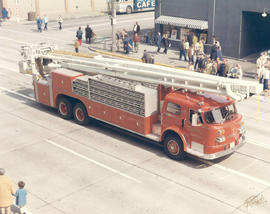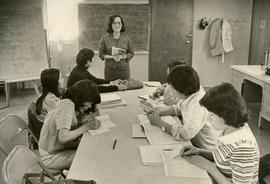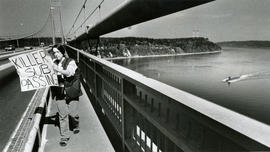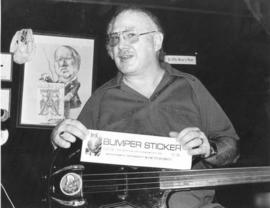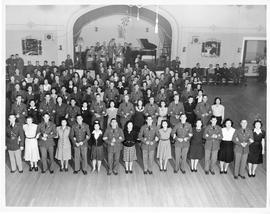The Puyallup Valley Chapter (PVC) of the Japanese American Citizens League (JACL) was established in 1930,(1) but first appeared in newspapers on November 18, 1937, hosting a "bazaar" at the Fife High School auditorium, featuring prizes and a 26 pound turkey feast.(2) According to PVC member and Fife mayor Robert Mizukami, this type of event was typical of the group's social orientation during the pre-war period.(3) The fairs were intended as a means of "acquainting the public with the citizen's group and it's activities," which included ceremonial dancing, traditional dress and promoting the Japanese language schools that operated in neighboring cities of Fife, Firwood, Sumner and Tacoma.(4) The JACL consisted of Nisei, or second generation, Japanese Americans, rather than their parent Issei generation.(5)
On June 18, 1938, PVC president Dan Sakahara hosted an event introducing the editor and publisher of the all English language Japanese-American Courier in Seattle and national chairman of the JACL James Y. Sakamoto.(6) The difference between these two speakers was representative of the economic and educational rift between chapter presidents and JACL leaders. While Sakahara was successful, he sustained his family through farming on Vashon Island, just outside of Tacoma.(7) In contrast, Sakamoto made his living by skillfully navigating between Japanese and American language and culture.(8)
George M. Egusa (9) was elected president in 1939 followed by Lefty (Saturo) Sasaki of Orting, from 1940 through 1942.(10) Throughout this period the organization continued to hold public events demonstrating Japanese culture alongside patriotic adherence to American values. In a press photo from August 1941 at the National Bank of Washington, Lefty Sasaki is shown posing with PVC Secretary and Publicist Tadako Tamura and other group leaders around a banker's desk to invest in defense savings bonds.(11)
By that year, the JACL had grown to 55 chapters across sixteen states with Los Angeles holding a regular Nisei Week annual event.12 On October 30, the PVC hosted an event supporting National Defense Week to help unify efforts between the 250 Nisei soldiers active at the Fort Lewis Army base and Caucasian soldiers.13 The evening included an informal dinner with Issei family members, dancing and singing the American national anthem, "marching forward, arm in arm with their fellow young Americans." (14)
This purpose was expressed on a larger scale by JACL National Secretary and Field Executive Mike Masaoka earlier that month in a series of public letters to President Roosevelt and US Senators. Masaoka, a twenty six year old veteran and former professor of rhetoric at the University of Utah, (15) was asserting the patriotic loyalty of the JACL amidst rumors that the organization was acting as a fundraising branch of "Japan's war chest," and demanded "an investigation to prove our loyalty." (16)
Following the PVC's National Defense Week celebration at the Odd Fellow's Hall, soldiers from Fort Lewis turned out in droves at the Puyallup Valley Chapter's annual winter event on December 2, 1941 the largest in the organization's history. Over 1,500 visitors poured into the Fife High School gymnasium to celebrate the organization's "social, cultural and civic activities."(17) Five days later, the Japanese government attacked the American military base Pearl Harbor, which led to America entering WWII, causing a nearly immediate shift in the JACL's function up to that point. Four days after the bombing, Mike Masaoka issued his Japanese-American Creed, a policy of "unswerving loyalty" to the United States. In it, he pledges:
"to support her constitution; to obey her laws; to respect her flag; to defend her
against all enemies, foreign or domestic; to actively assume my duties and
obligation as. a citizen cheerfully and without any reservations whatsoever, in the
hope that I may become a better American in a better America." (18)
This same day the Tacoma News Tribune released a statement that there was a "flood" of applications for birth certificates amongst the Nisei community to establish their US citizenship. (19) Just as the organization had helped the community attain their driver's license registration in the past, (20) Lefty Sasaki of the PVC and leaders of the Tacoma chapter offered to help process these requests from many of the estimated 8,882 Nisei living in Washington as of the 1940 census. (21) This seems to be the inciting incident which caused some Japanese Language schools to reopen as headquarters for civilian defense, as was the case in Tacoma's Japanese Language School becoming the Japanese Community Center.(22) Schools that were not converted to these functions were shuttered by a resolution from James Y. Sakamoto on grounds that they would arouse "misunderstanding of the loyalty of Japanese in America." (23)
When Executive Order 9066 was issued by President Franklin Roosevelt on February 19, authorizing the forced "evacuation of all persons deemed a threat to
national security from the West Coast to relocation centers further inland," (24) these makeshift community centers across Washington became registration stations, which would facilitate the US government to route citizens to camps. JACL members also organized these efforts independent from the US government. As Seattle JACL secretary noted "We don't know where we're going- or when we are going but we do know we are going. The United States government has complete information about us, but we want our data, too." (25)
In the immediate aftermath of Pearl Harbor, the JACL leadership established working relationships with the FBI and naval intelligence officers to pinpoint "subversive Japanese organizations on the west coast." Recorded informants include JACL leaders Saburo Kido, Ken Matsumoto and previously mentioned Field Executive Mike Masaoka. (26) Masaoka maintained a working correspondence with Milton Eisenhower, the head of the War Relocation Authority (WRA), beginning in March of 1942, sending recommendations for how to operate the camps, which both parties attest to influencing later designs.(27) Masaoka also worked with the US government to indict possible Japanese American subversives in court (28) as well as before War WRA committee hearings. (29)
In early March 1942, Seattle JACL leader James Sakamoto spoke publicly about having an "intelligence unit" which collaborated with the FBI and explained how this
relationship could be used as a means of avoiding forced removal, suggesting that the Issei could be placed under custody of the Nisei. If the Issei generation didn't report twice a week to the Nisei, "the league's intelligence unit would inform the FBI." (30)
Soon after, Sakamoto's longtime newspaper competitor Dick Takeuchi, editor of The Great Northern Daily News in Seattle, submitted their final issue on the topic of expulsion, before Takeuchi himself was incarcerated at the Minidoka War Relocation Center. (31) The Great Northern's final issue was one page of English and seven pages of Japanese, consisting of the latest news and illustrated maps of the newly developed concentration camps, (32) including Camp Harmony in Puyallup, WA, where Sakamoto was elected Chief Supervisor on the 24th of April. (33)
"Camp Harmony" or the Puyallup Assembly Center, was really the Washington State Fairgrounds, converted into a series of barracks with a central mess hall over the course of 14 days. (34) Camp Harmony was staffed entirely by Japanese Americans, under the direction of the US military, so they might "resume their activities in Puyallup with as little inconvenience as possible." There is little hard evidence that this staff was made up of the Seattle JACL members that Sakamoto led, but some appointed staff, such as the Seattle Hotel Building Cooperation's William Y. Mimbu indicates that administrative positions were assigned to prominent figures in Sakamoto's political orbit. (35)
The Puyallup Valley Chapter leaders are nowhere to be found on this staff list, and at least one leader was incarcerated there. League Secretary and Publicist Tadako Tamura wrote this testimony for the Tacoma News Tribune just after arriving in Camp Harmony:
"At this time, we don't believe it necessary for us to leave a message of farewell
to this part of America. Or many Caucasian friends have bade us the most
reassured goodbyes 'for the duration.' The soil we worked... has become too
much a part of us to leave so easily. We hope the valley which was, and which is
our home, will continue to yield." (36)
In an account the following month, the Tacoma News Tribune caught up with Tamura building a small flower garden outside of her barracks in Area C, where other former
residents of the agricultural towns Fife and Orting had settled. This drive to get back to farmland and out of the camps was capitalized on by the US government who coordinated "emergency harvest camps" and "victory vacations," where young Japanese Americans were allowed out in order to compensate for the nation's recent agricultural vacancies. (37)
The article goes on to note an American flag floating over the entrance of Area C, which had recently been raised in a patriotic ceremony where Sakamoto was the main speaker. (38) This event was typical of the camp's emphasis on "the spirit of Americanism and democratic process," suggested by Masaoka in his April 6th letter to WRA director Milton Eisenhower. (39) While Masaoka's suggestions are generally concerned with education and maintaining civil liberties under incarceration, there is a dissonance in Masaoka's direction that "no intimation or hint should be given that they are in concentration camps or in protective custody, or that the government does not have full faith and confidence in them as a group and as individuals." (40) Masaoka indicated repeatedly throughout the 18 page letter that camps were intended to prove Japanese American loyalty, when their very existence demonstrated a government who strongly believed the contrary. In addition, demonstrating proof of innocence becomes exponentially more difficult from behind bars.
Tadako Tamura surfaces again in October 1942 as a contributing artist for The Minidoka Irrigator, the six page weekly newspaper for the 10,000 Japanese Americans incarcerated at the Minidoka War Relocation Center, founded by displaced Seattle newspaperman Dick Takeuchi. (41) The first two volumes traveled back to Seattle describing Minidoka as "a vast stretch of sagebrush, stubble and shifting, swirling sand... the sort of place people normally would traverse only to get to another destination." Throughout the course of 1942, the JACL lost favor within the community for failing to push back against the US military, deporting potential rivals and removing Japanese language reading materials. (42) Another issue which emerged over time was incarceration leading to seized property and land that the Issei had devoted their lives to developing. While these actions were brought on by major increases of Alien Land Law prosecutions, archaic legal holdovers from the nineteenth century which prohibited Issei citizens from owning property, very often, land titles were lost due to the chaotic nature of displacement. (43)
Faced with incarceration, former PVC president Dan Sakahara, who introduced James Sakamoto at a league event earlier, leased his farm on Vashon Island to Deputy Sheriff Finn Shattuck before he and his family were eventually moved to the Tule Lake Relocation Center in Northern California. Despite continued requests through 1944, Finn Shattuck sent no money for the crops harvested on Sakahara's land. When the family was freed, Dan Sakahara did not legally pursue the funds he was owed for his farmland, the largest acreage on Vashon Island, and instead chose to begin a new life in St. Louis. (44)
Following the repeal of Executive Order 9066 in 1946, the Puyallup Valley Chapter went dormant, not surfacing in newspapers again until 1958.45 According to future PVC president Robert Mizukami, (46) the reason for this was a scarcity of potential members. (47) This scarcity was described by Mike Masaoka, who emerged back into the public sphere in 1947 as the Washington D.C. Legislative Director of the Antidiscriminatory Committee for the JACL. In the article, Masaoka detailed the current state of Japanese American displacement. "Approximately 60 percent of the West Coast Japanese evacuated in 1942 have returned to the area... 15 percent have permanently settled in the East and Midwest and the other 25 percent are in a state of flux." (48)
This scarcity led to the Puyallup Valley Chapter and the Tacoma chapter combining members to reform the organization, with Kaz Yamane as PVC president and weekly meetings at the Tacoma Buddhist Church. (49) The group's ideology and mission changed in the chapter's reactivation. As Mizukami notes in an oral history conducted by the Densho Digital Archive, "it became more of a civil rights group than we were before. I think, like I said previous, prior to the war, it was more of a social group that did all these other activities. So since the war, I mean, its purpose has changed a little."
One of the most significant impacts that the organization made was the repeal of the Alien Land Law, which PVC president Dr. Sam Uchiyamo made a "prime objective" of the Northwest Council of the JACL beginning in 1960.50 After an extensive grassroots campaign organized by the Seattle JACL and defeated twice by referendums, (51) the law was finally repealed in 1966. (52) The repeal of the law wasn't publicly celebrated by the PVC, then led by Frank Mizukami. Instead, the league president appeared in newspapers donating copies of America's Concentration Camps, marking the 25th anniversary of the event,53 holding piano recitals for elementary school children54 and highlighting his expansive primrose greenhouse located in Fife. (55)
Since this accomplishment, the Puyallup Valley Chapter of the Japanese American Citizens League has remained an active member of the Puget Sound community, contributing to a scholarship fund, (56) hosting historical programs for adults as well as school children (57) and continuing to host their annual cultural outreach events featuring ceremonial dance and traditional dress in Fife High School, just as they had in 1937. (58)
